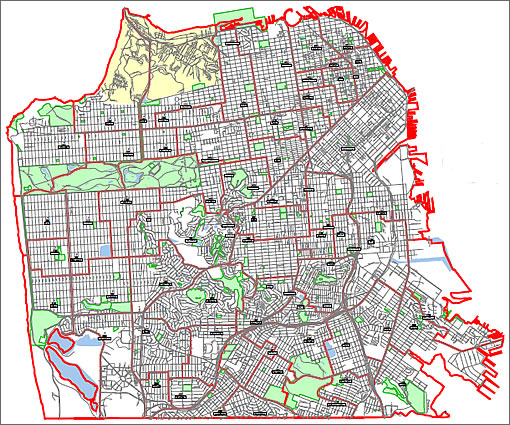
The final map won’t be released until Wednesday, and there are a few amendments in the works, but as a plugged-in tipster notes, the new draft map for elementary school attendance area boundaries in San Francisco has been released.
In the words of our tipster:
Overall, it looks like a pretty good map. Not too much gerrymandering.
Still, I can’t help but wonder how residents at San Jose & 24th are feeling about the new “neighborhood schools.” The realtors say they live in Noe Valley, but their kids will be going to Chavez Elementary. (And if the board proceeds with the middle school feeder plan, they’ll be at Horace Mann Middle School with the kids from Webster and King Elementary.) Looks like the 26th Streeters had a better lobby.
And as it relates to real estate: SocketSite Gets Schooled By A Plugged-In Reader.
∙ SocketSite Gets Schooled By A Plugged-In Reader [SocketSite]
∙ Map: Draft Elementary Attendance Areas [sfusd]
∙ Summary of Amendments to Draft Attendance Areas [sfusd]
∙ San Francisco Association Of Realtors New Neighborhood Map [SocketSite]
Expect rental prices to change quickly!
So i live directly on the border, right where the red line is… how do i find out which school my kids will be going to?
is there a website where you can type in your address and it tell you?
I wonder how API scores will be impacted by this new policy. The elementary school district I live in isn’t the greatest API.
And by “isn’t the greatest”, I mean the second worst general public elementary school in the city.
@live on the border
You will likely be assigned to a different school than your neighbors across the street. Which ever district your side is closer to is the one you’ll be assigned. (e.g. those on the north side of geary attend the district to the north, those on the south, the southern district)
On a broader note, this event is likely to reorganize the city a lot more than one would expect. I have to wonder, first, whether schools that are not right at the top of the lottery will get sucked back into the fold as fewer people try hard to get into them (the very best are likely still desirable to all of those who live in a ‘bad’ district).
Second, what about schools like Muir, that has a very low rating on the sources I checked yet now includes Alamo Square and Hayes Valley, two populations whose (I imagine anyway) kids stereotypically do well in school.
Third, I didn’t realize so many kids lived in the Northeast part of town! Look how small those districts are compared to say, the Richmond.
All in all, I think this is likely to have a detectable, albeit unmeasureable, affect on real estate prices.
Whether your kid goes to Sutro or Alamo isn’t all that important, as much as new parents fret about such things. (We had one at each, both fine schools.) But where’s thelist that shows the middle school feeder schools and where your kid will go to high school? That’s when it starts to really matter – and when parents tend to want to leave town again.
^^^ Middle school feeder pattern implementations have been delayed for a year due to vocal complaints by some parent groups. Next year’s entering MS students still need to apply district-wide via lottery.
Agreed that the feeder pattern will be critical, but — hopefully — if entire clusters of “high-performing” students enter less desirable schools simultaneously there could be dramatic improvements almost immediately. I would hope parents would consider that, and not focus entirely upon historical school issues.
Well, I wouldn’t call these “neighborhood schools” given that anyone in a CTIP1 area gets first pick of schools anywhere in the district after siblings and kids in local CDCs (who are usually poor). Our new assignment area is Clarendon but after SFUSD released the map showing how many CTIP1 area families had Clarendon listed as their first choice (looked like ~30-50 on page 10 of the report linked below), we’re pretty happy we’re already in a citywide school.
http://sfusd.ggnet.net/files/city-wide-schools-July-6-2010.pdf
As we calculated it, last year Clarendon had 40+ siblings for 88 spots. Add some CDC kids and the CTIP1 families (probably a few more than on the map because CTIP1 families get in before neighborhood kids even if it’s not their first choice and they didn’t get into, say, Alice Fong Yu) and no one in our neighborhood assignment area has much chance of actually enrolling. I’m guessing it will be the same for high-demand central schools like Grattan and Alvarado as well. I was surprised at how many CTIP1 families were applying to Lakeshore, too. That’s quite a trip.